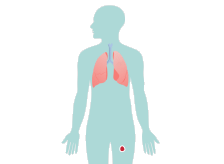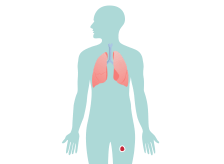Indications
-
ELIQUIS (apixaban) is a prescription
medicine used in adults to reduce the risk of stroke and blood clots in people who have atrial fibrillation (AFib), a type of irregular heartbeat, not caused by a heart valve problem. -
ELIQUIS (apixaban) is a prescription
medicine used in adults to treat blood clots in the veins of your legs (deep vein thrombosis-DVT) or lungs (pulmonary embolism-PE), and to reduce the risk of them occurring again after receiving treatment for blood clots. -
ELIQUIS (apixaban) is a prescription
medicine used in children from birth and older to treat blood clots in the veins of legs and lungs (venous thromboembolism) after at least 5 days of initial anticoagulant treatment, and to reduce the risk of them happening again. ELIQUIS was not studied and is not recommended in children weighing less than 5.7 pounds (2.6 kg). -
ELIQUIS (apixaban) is a prescription
medicine used in adults to help prevent a blood clot in the veins of your legs (deep vein thrombosis-DVT) and lungs (pulmonary embolism-PE) of people who have just had hip or knee replacement surgery.
Indications
-
ELIQUIS (apixaban) is a
prescription medicine used in adults to reduce the risk of stroke and blood clots in people who have atrial fibrillation (AFib), a type of irregular heartbeat, not caused by a heart valve problem. -
ELIQUIS (apixaban) is a
prescription medicine used in adults to treat blood clots in the veins of your legs (deep vein thrombosis-DVT) or lungs (pulmonary embolism-PE), and to reduce the risk of them occurring again after receiving treatment for blood clots. -
ELIQUIS (apixaban) is
a prescription medicine used in children from birth and older to treat blood clots in the veins of legs and lungs (venous thromboembolism) after at least 5 days of initial anticoagulant treatment, and to reduce the risk of them happening again. ELIQUIS was not studied and is not recommended in children weighing less than 5.7 pounds (2.6 kg). -
ELIQUIS (apixaban) is a
prescription medicine used in adults to help prevent a blood clot in the veins of your legs (deep vein thrombosis-DVT) and lungs (pulmonary embolism-PE) of people who have just had hip or knee replacement surgery.
In the 3 sections below, learn about the connection between DVT and PE, understand the role of blood thinners, and get information about ELIQUIS.

After my first experience with DVT/PE, my doctor and I decided that ELIQUIS would be the right choice for me to help reduce the chance of DVT/PE blood clots happening again.
Brian is a paid ambassador.

I put off going to the doctor, and when I found out I had a DVT blood clot, I cried because I knew it could have been so much worse. Now, I’m very proactive in reaching out to my doctor if I have any questions or concerns.
LaVon is a paid patient ambassador.
Deep vein thrombosis (DVT) & pulmonary embolism (PE) are serious conditions.



A DVT is a blood clot that forms in a deep vein, usually in the thighs or pelvis



The clot, or a part of the clot, may break off and travel through blood vessels toward the lungs



If that blood clot reaches the lungs it is called a PE. A PE can reduce or cut off blood supply to the lungs, and may even cause sudden death

Swelling in the leg or around a vein in the leg

Pain or tenderness felt when standing or walking

Redness around the affected area
If you have symptoms of DVT or PE, it is important that you go to your doctor or to the hospital right away. Don’t wait to see if the symptoms will go away—waiting could lead to serious complications. Keep in mind that sometimes patients can have a DVT and/or PE and not show any symptoms at all.

Difficulty breathing

Faster than normal or irregular heartbeat

Chest pain

Very low blood pressure, light-headedness, or fainting

Coughing up blood
If you have symptoms of DVT or PE, it is important that you go to your doctor or to the hospital right away. Don’t wait to see if the symptoms will go away—waiting could lead to serious complications. Keep in mind that sometimes patients can have a DVT and/or PE and not show any symptoms at all.
Who is at risk for having another DVT/PE?
If you’ve had deep vein thrombosis (DVT) or pulmonary embolism (PE), you may be at risk of having another case of DVT or PE. That’s known as a “recurrence.” Each patient’s risk of recurrence varies.

How common is recurrence?
It’s estimated that 1 out of 3 patients (33%) with DVT/PE have a recurrence within 10 years.
The risk of recurrence is highest within the first year after the initial DVT/PE.
In some cases, the risk of recurrence can remain years after the first event.



Please see U.S. Full Prescribing Information, including Boxed WARNINGS and Medication Guide.
YOU MAY ASK
What’s the role of a blood thinner for DVT/PE?
Blood thinners are the most common treatment for DVT/PE.
THEY TREAT DVT/PE BY
 Reducing the ability of the blood to clot
Reducing the ability of the blood to clot
 Reducing the risk of further clots developing
Reducing the risk of further clots developing
Treatment can help reduce the risk of recurrence
Taking certain blood thinners can help reduce the risk of recurrence. And that is why, after at least 6 months of a prescription treatment for DVT/PE, your doctor may ask you to continue on ELIQUIS—a blood thinner that is clinically proven to reduce the risk of recurrence of DVT/PE after initial treatment for DVT/PE.

Because they help reduce the risk of blood clots forming, blood thinners increase the risk of bleeding, which can be serious, and may lead to death.
While taking a blood thinner, you may bruise more easily and it may take longer than usual for any bleeding to stop. Be sure to seek medical attention right away if you have signs or symptoms of bleeding, such as unexpected bleeding or bruising, or bleeding that lasts a long time. You may have a higher risk of bleeding if you take blood thinners and take other medicines that increase your risk of bleeding.
Click here for more comprehensive information you should be aware of about bleeding and ELIQUIS. Be sure to call your healthcare provider right away if you fall or injure yourself, especially if you hit your head. Your healthcare provider may need to check you.
Your doctor may encourage you to limit activities that may cause injury and take some precautions, such as:

Take extra care using knives, scissors, and nail clippers

Use an electric razor

Wear shoes or non-skid slippers in the house

Use a soft toothbrush and waxed dental floss

Wear gloves when using sharp tools or doing yard work
WHAT IS ELIQUIS?
ELIQUIS is a prescription medicine used in adults to treat blood clots in the veins of your legs (deep vein thrombosis-DVT) or lungs (pulmonary embolism-PE), and reduce the risk of them occurring again after receiving treatment for blood clots. Only you and your doctor can decide if ELIQUIS is right for you. ELIQUIS and other blood thinners increase the risk of bleeding, which can be serious, and may lead to death.



Please see U.S. Full Prescribing Information, including Boxed WARNINGS and Medication Guide.


For adult patients with DVT/PE:


ELIQUIS was proven to
TREAT AND REDUCE
THE RISK
of another DVT or PE blood clot


In a 6-month study, ELIQUIS and
LOVENOX® followed
by warfarin
had similar efficacy results
Almost 98 percent of patients
on ELIQUIS® (apixaban)
didn’t experience another DVT/PE
In this study, 2.7% of LOVENOX®/
warfarin patients had
a recurring
DVT/PE vs. 2.3% of ELIQUIS patients.


And ELIQUIS has
SIGNIFICANTLY
LESS MAJOR BLEEDING*
vs. LOVENOX® followed by warfarin


ELIQUIS has both
In clinical studies for adult patients with DVT/PE, ELIQUIS:
the risk of another
DVT/PE
Treated DVT/PE blood clots and had less major bleeding in a 6-month study vs. LOVENOX® (enoxaparin) followed by warfarin.
Reduced the risk of another DVT/PE in a separate 12-month study vs. placebo.
ELIQUIS and other blood thinners increase the risk of bleeding, which can be serious, and may lead to death.
In the 6-month study vs. LOVENOX® followed by warfarin: ELIQUIS and LOVENOX®/warfarin had similar efficacy results.
Almost 98% of patients on ELIQUIS didn’t experience another DVT/PE blood clot after initial treatment for DVT/PE.
In this study, 2.7% of LOVENOX®/warfarin patients had a recurring DVT/PE vs. 2.3% of ELIQUIS patients.
If you’re taking warfarin, consider talking to your doctor about ELIQUIS for both of these reasons: ELIQUIS was proven effective to treat deep vein thrombosis (DVT) and pulmonary embolism (PE) blood clots. Plus, ELIQUIS had significantly less major bleeding* than the standard of care at the time, LOVENOX® followed by warfarin.
*Major bleeding included noticeable bleeding with at least 1 of the following—a transfusion of 2 or more units of blood; bleeding that occurred in the brain, spine, eye, inside the abdomen, around the heart, in a joint, or in a muscle, leading to damage; or fatal bleeding.
Please see Important Safety Information, including Boxed WARNINGS, below.
LOVENOX® is a registered trademark of sanofi-aventis U.S. LLC.




